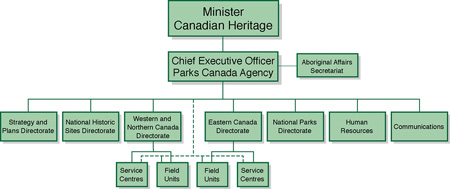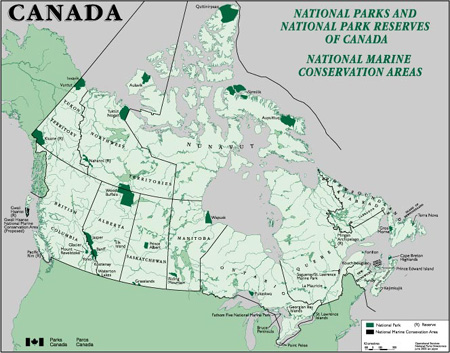| Français | Contact Us | Help | Search | Canada Site | |
| What's New | News Releases | Library | Employment | Events |
|
|

PARKS CANADA
|
|||||||||||||||
Click here for a larger view. |
Governance
Parks Canada's Executive Board is comprised of the Chief Executive Officer, the four Directors General, the Chief Administrative Officer, the Executive Directors in Quebec and the Mountain Parks, the Executive Director Ecological Integrity, the Chief Human Resources Officer, the Senior Financial Officer, the Director of Communications and the Senior Legal Counsel. As the senior decision-making body, the Executive Board sets the long-term strategic direction and priorities for the organization. The Board also approves resource allocations, new initiatives and service innovations proposed each year in national office, field unit and service centre business plans. The CEO reports to the Minister of Canadian Heritage.
The National Parks and the National Historic Sites Directorates develop program direction and operational policy for Parks Canada's natural and cultural heritage programs respectively. The Strategy and Plans Directorate provides business, information technology, real property and financial services. The Human Resources National Office provides overall direction for the function as well as supporting Parks Canada's responsibilities as the employer. The Communications Directorate provides strategic communication support to the Agency. The Director General Eastern Canada and the Director General Western and Northern Canada give strategic direction to the field units and service centres.
The Aboriginal Affairs Secretariat is responsible for the overall coordination of Aboriginal issues in Parks Canada (with the exception of land claim issues) and reports directly to the CEO.
Program delivery, including on-site services to visitors, is the responsibility of Parks Canada's 32 field units. Field units are groupings of national parks, national historic sites and national marine conservation areas. Their proximity to each other allows them to share management and administrative resources. The field unit superintendents are accountable to the CEO through annual business plans and reports. They report to the Directors General for Eastern Canada and Western and Northern Canada.
There are four service centres, located in the following areas; Halifax, Québec City, Cornwall/Ottawa and Winnipeg, with smaller branches in Calgary and Vancouver. Service centres support the organization in a variety of professional and technical disciplines, such as, biology and history. Centres report to the Directors General for Eastern Canada and Western and Northern Canada and are accountable to the CEO through their annual business plans.

National Programs
For more than a century, the Government of Canada has been involved in protecting and presenting outstanding natural areas and in commemorating significant aspects of Canadian history. Parks Canada manages three major programs: national parks, national historic sites and national marine conservation areas.

System of National Parks
The program aims to protect representative examples of natural areas of Canadian significance in a system of national parks and to encourage public understanding, appreciation and enjoyment of this natural heritage so as to leave it unimpaired for future generations.

System of National Historic Sites
The national historic sites program fosters knowledge and appreciation of Canada's past through a national program of historical commemoration. Sites, persons and events determined to be of national historic significance are designated by the Minister of Canadian Heritage on the advice of the Historic Sites and Monuments Board of Canada.

System of National Marine Conservation Areas
In 1986, the national marine conservation areas program was established to protect and conserve for all time national marine areas of Canadian significance that are representative of the country's ocean environments and the Great Lakes and also, to encourage public understanding, appreciation and enjoyment of this marine heritage so as to leave it unimpaired for future generations.

Other National Programs
Parks Canada directs or coordinates delivery in other programs that conserve aspects of Canada's heritage. These programs are the: Federal Heritage Buildings Program, Heritage Railway Stations Program, Canadian Heritage Rivers System Program, Federal Archaeology Program, National Program for Grave Sites of Canadian Prime Ministers and the new Historic Places Program.

International Obligations
Parks Canada contributes to international heritage conservation through its leadership and participation in international conventions, programs, agencies and agreements. It represents the Government of Canada on the United Nations Educational, Scientific and Cultural Organisations Convention Concerning the Protection of the World Cultural and Natural Heritage (the World Heritage Convention). The Agency is also the state member for Canada in the World Conservation Union (IUCN) and serves jointly with the Canadian Conservation Institute as the representative to the International Centre for the Study of the Preservation and Restoration of Cultural Property (ICCROM).

Stakeholder Participation
Parks Canada relies on the support and interest of members of the public and stakeholders in Canada's systems of heritage areas such as:
- other owners of national historic sites;
- co-operating associations;
- business partners, chambers of commerce, community groups;
- federal, provincial, territorial and municipal governmental organizations;
- professional associations, tourism partners, universities, colleges and volunteers
These various groups have in common a desire to influence and support the creation, designation, commemoration and operation of Canada's heritage places.

Parks Canada Planning and Reporting Framework
The foundations of Parks Canada's accountability framework are the legislative and policy authorities for national programs. These authorities are, in turn, elaborated by Parks Canada's Guiding Principles and Operational Policies, which are approved by the Minister and tabled in Parliament.
System Plans set out the basis for establishing new national parks, national marine conservation areas and national historic sites. Management plans are prepared in consultation with Canadians for each heritage place administered by Parks Canada. Although they are a long-term blueprint for conservation, presentation, development and operations, they are reviewed every five years.
The Report on Plans and Priorities (RPP) and the Corporate Plan for the Parks Canada Agency are prepared annually to identify objectives, results, key activities, performance expectations and financial plans for the approaching three and five-year period. Business Plans are prepared by each field unit, service centre and national office directorate to outline the current operation and objectives over the next three years. The Departmental Performance Report and Annual Report state yearly accomplishments and the use of financial resources.
Every second year, a State of Protected Heritage Areas Report assesses the ecological and commemorative integrity of Canada's heritage places, services offered to visitors and progress in establishing new heritage places. The Sustainable Development Strategy, prepared every three years, outlines Parks Canada's efforts to integrate environmental, economic and social factors in its policies and programs, planning and reporting and in its operations.
The final element of the accountability framework for people management is the independent Report on Human Resource Management that is to be submitted to parliament every five years.
Reports and plans are available on the Parks Canada website at:
http://www.parkscanada.gc.ca/library/index_e.htm#plans.
| Click on the image to view a larger size. Some scrolling may be necessary. Click here to view and print PDF version (1.5 MB). About PDF. |

| Click on the image to view a larger size. Some scrolling may be necessary. Click here to view and print PDF version (553 KB). About PDF. |

The 145 National Historic Sites administered by Parks Canada
Newfoundland
|
Ontario continued
|
Return to the Table of Contents
|
|
| Last Updated: 2002-08-23 |  |
Important Notices | |

